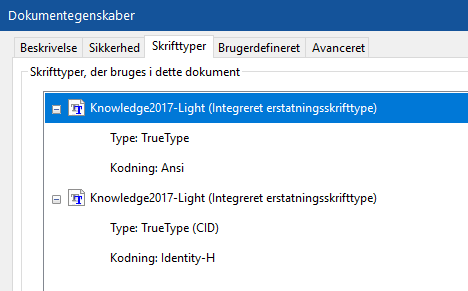-
Posts
2,109 -
Joined
-
Last visited
Posts posted by Jowday
-
-
1 hour ago, Mark Ingram said:
Based on my experience so far, nearly all problems we've had with hardware acceleration or crashes during rendering have been solved by uninstalling and reinstalling the latest driver (for some reason, just updating doesn't tend to fix the issue).
It could be interesting to hear what the driver manufacturers has to say about it - and what can be done (possibly by them). If Mister and Mrs Nesbit has to uninstall and reinstall the exact same driver to make something work then human evolution is paused. Personally I am not interested in Windows 14 BIG ASS 128-bit or OS X XTRA SHINY BLING - I just want my tools to assist me.
-
No global layers and soft proofing “Per page” ... I get the feeling that someone focused entirely on technical performance and basic layer concepts early in the proces and without much thought (or involvment of professional customers) stood with an unprofessional foundation for Publisher. And a bizarre one.
How did they end here with such a poor platform after starting from scratch and after 25 years in the Industry? Any yet they sell it as professional.
Professional MEANS something. At least to professionals. But they were obviously never involved.
-
-
-
-
-
-
-
17 hours ago, GregB said:
Still something for Affinity to address as buried too deep for new users.
Indeed. Options hidden deep inside the program and the need to consult manuals is not acceptable or good usability. There is no "standard" involved - only de factor "doing it wrong" standards from 1992 before usability was professionalized and mover away from developers.
You do not bury features so deep. Access to distribute options should be easily accessible from the default toolbar somehow - if "hidden" still only one click away from the alignment options. How to do it is not up to random people from the Internet in a forum. Enter professional user experience designers.
I could write a book about what some of you don't know. It doesn't represent anything else than what you know - and don't. Let user experience designers make the calls.
I spent hours yesterday in InDesign. Today and now on my lunch break after two hours of meetings with a developer team and two user experience designers and two product owners - me being one of them. Every scenario examined from any angle - user tested on mockups, prototypes, early betas and the release candidate. And now one more meeting. Coming here is depressing. It is like stepping back in time. I see no signs of the professionalism or ambitions I am used to from work or from InDesign. I didn't see anyone working like Serif since 1997 personally. Whow!
Software that effectively needs a HELP? ASK WALT! button and a constantly open manual is not quite there yet.
-
On 2/14/2021 at 7:22 PM, thomaso said:
While ID is able to use their original Adobe library:

… on mac Affinity appears to use the macOS internal PDF library …

… which might be related to this: https://www.pdflib.com/products/pdflib-family/pdflib-pdiHowever, I wonder whether the conversion of curving font text is in fact done by the PDF Library – or rather by Affinity before it transfers the data to the Lib. You could test if you notice a visual difference by curving the text in Affinity before opening the export options.
That means that the OS X edition of the PDF lib was used for the Mac version of Affinity Publisher. It is not an Apple developed PDF lib in OS X. Or internal lib.
Adobe - world class specialists in PDF - made 15 versions of their own PDF library. Output quality is top notch. I witnessed that as early as 1999.
Serif includes licensed code from a third party company in their Affinity programs and I would be surprised if it doesn't handle the font conversion as well. In either case I don't see much hope. Serif struggled with vector math in the Boolean operators and expand stroke for years. Their SVG is also far from great. PDFlib GmbH is an old company from around 1997 and if they didn't optimize their fonts to curves code yet they never will.
Adobe FTW.
-
Actually I believe the vectorizing of the fonts is performed by a third party product, PDFLib, Serif used it for several years for creating PDF’s.
-
1 hour ago, EdgarWiser said:
Got it.
As you already mentioned, it really does seem to make sense.And do you know if there is any possibility for the serif team to pay attention to this algorithm improvement?
I just assume Adobes algorithms do a better job. They have the best specialist that finetuned their product and output for years.
Serif may or may not want to improve theirs but they are a small company that must prioritze what they develop.
Also their typical customer is probably not a picky professional so it may not be a priority to their customers either.
Publisher is new budget software. InDesign is mature premium software. You get what you pay for.
Take care 🙂
-
24 minutes ago, EdgarWiser said:
Wow !!!! Thank you very much for the information and explanations @thomaso and @Jowday
The problem really disappears when I export the pdf with the included typography.My problem is solved. Thx thx.!
But now I was intrigued by the issue of curved exports ...
As we discussed earlier, it seems then that there is a 'primary problem' related to the rendering of curves, I say this due to the fact that, the same behavior does not happen in web pdf viewers when we export the entire file in curves through
Indesign.Why does this happen when exporting in Publisher?
The printing company (Knowledge font family) owns the company Thomson Reuters which I create graphic and advertising pieces for them here in Brazil.
I believe it is because Adobes convert to curves algorithm is better somehow.
-
Hey Ben, you should go here and change your nickname to something else than your e-mail; spammers may crawl this forum and harvest it.
https://forum.affinity.serif.com/index.php?/settings/
🙂
-
1 hour ago, irokiee said:
yes - so I hope for a quick fix in the production version 😁...
Odds are pretty big - the beta can't be too far away from being released. But great you could verify that the fix works! 🙂
Miłego weekendu
-
There is no typography mapping during import? 😞
-
-
1 hour ago, loukash said:
Yep, I like it, too. But it hasn't been there all the time either: it came with CS4.
Correct and I do not use it that much myself. I am also not sure Serif will implement it at all. Not before the backlog is almost emptied.
-
I guess this one is for you @Patrick Connor
Is it possible to configure the forum to use a bug report template and somehow implement it in a meaningful way? Not a thorough one for internal use but rather just a template with some sections/questions so the average user and every user gets an idea about what you need to know and what really would be nice to know.
Getting as much information as possible from the first post - not needing to ask for more details - not needing to wait for it - not risking the user doesn't replies etc.
Your supporters ask and ask for details and samples week after week.
-
So you see the problem when using this font and exporting it as curves?

The font seems to be integrated in the InDesign PDF; not in the Publisher PDF. That means that two different rendering algorithms present the letters in the PDF's and that could easily explain the difference.
To really compare the two in Adobe Reader they both need to be exported as vector.
Is it a free font we can download somewhere?
-
It certainly looks like xBRZ preserves shapes much better. Can we see the original before scaling?
-
51 minutes ago, All Media Lab said:
sebp I never optimize in https://www.xnview.com/en/xnconvert/ and still have a small file size and for jpg I use: https://www.jpegmini.com/ you can drag and drop a folder with 500 images that are optimized in sec.
Our scenario:
- Source: Original TIFF files from professional photographers
- We simply always generate output files from the source for maximum quality and smooth colour transitions (if possible)
- Edit and crop in ... Adobe Photoshop
- Save while adjusting compression ratio using 100% preview and manual inspection
We are dealing with medium sized images (real photos of real people) for article headers. Smallest size possible is crucial as we now have 60 mio. unique visitors every year. Server and bandwidth usage matters big time. But the visual quality must be superb. No artifacts. Servers of course use smaller versions when the visitor use a smartphone or a tablet.
Non-photos are all SVG's. So the SVG code must be perfect as well. Our developers inspect each and every SVG.
So we never batch convert and re-compress anything. Wouldn't recommend it either. But in some cases it can make sense, of course.
No WebP output and no optimized svg... no go. In our case.
-
-
Now that we have an excellent export preview it would make total sense with webp as an actual export option in Photo. Photo can even be one of the first tools to offer a great user experience and UI for webp export.
Sometimes you can make do with bulk - in my case I have editors dragging the quality slider manually while inspecting photos during export. The lack of elegant user interface for the average person kept me us from adapting webp for now.
It is great to have such options - but they are rarely used by staff outside it-departments.
The problem with bulk is the one quality parameter used for all files.










We want to help (again)
in News and Information
Posted
I am not speculating - I am just ready to pay even a significant upgrade price if the step up from 1.x to 2.x is interesting. If it is not I will loose the last faith in the product I have. How many tiny increments and years before the product is - or is not - significantly improved?
If they only now seek to fund the future with low upgrade prices and a small feature set ONCE AGAIN how would they motivate the entire base to follow them into a slow uncertain future with more minor upgrades and finally lagging behind. A promising version 2.0 upgrade of all three Affinity apps would encourage, inspire and assure bigger fish than the current massive mass of hobbyists and small entrepreneurs that the products will indeed mature into something truly professional.
A major update is also a unique chance to clean up the mess and mistakes and build a better and more user friendly interface.
"Generate a ton of revenue" - THAT is speculation.